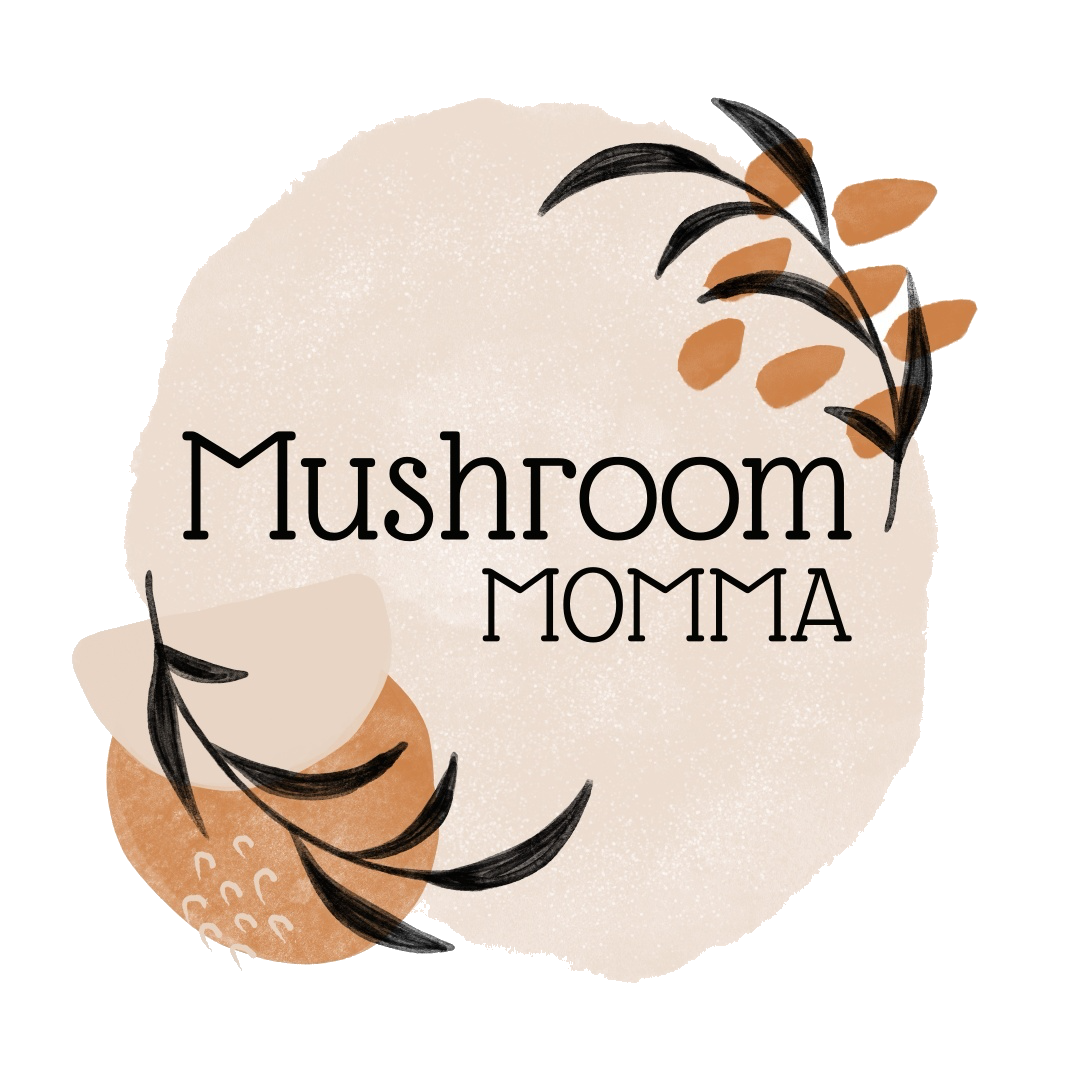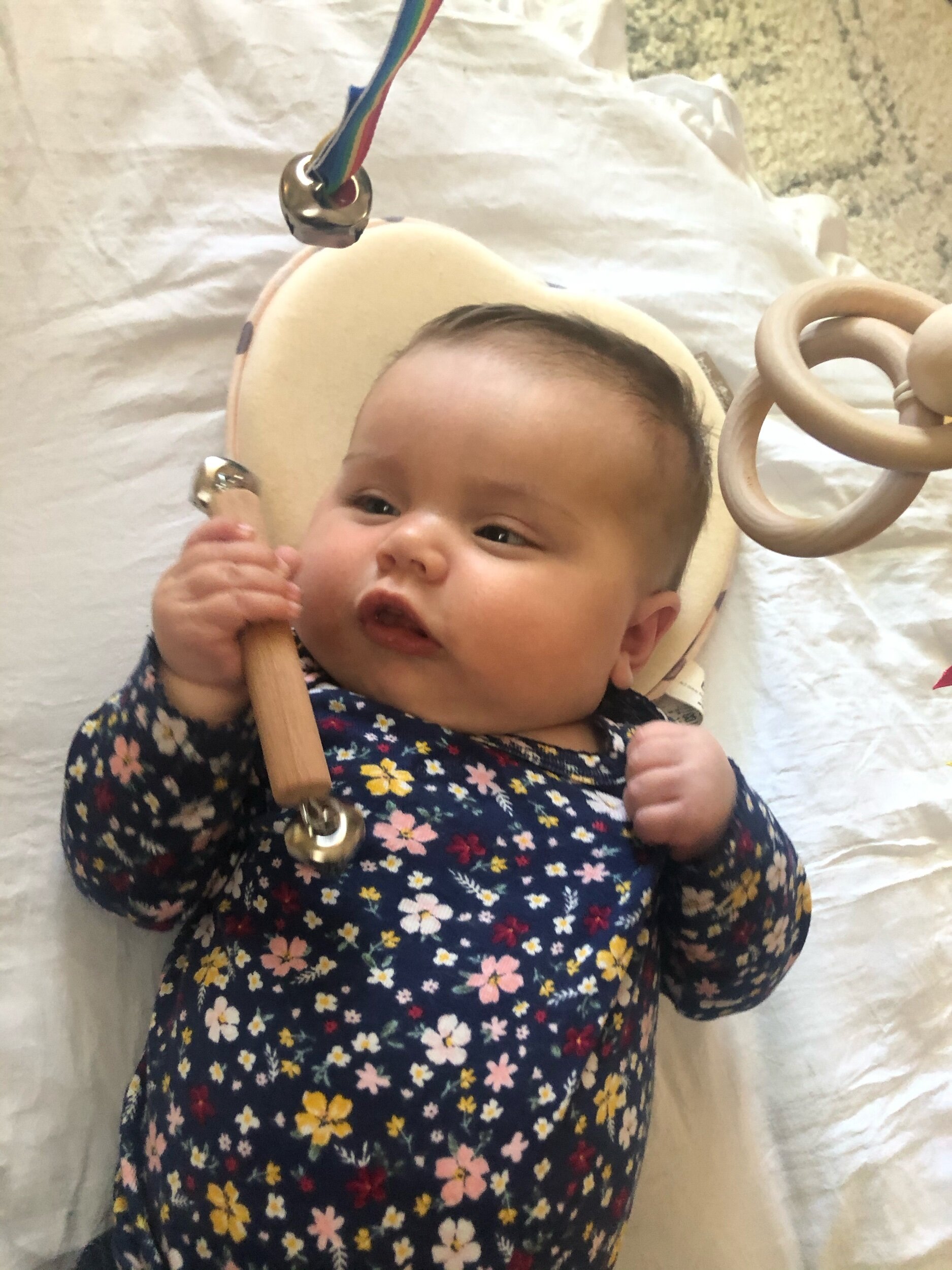Montessori from Birth: Month 5 and 6

This post may contain some affiliate links. For more information, visit my disclosure page.
“The things he sees are not just remembered; they form a part of his soul.”
Dahlia using a knitted ball, also known as a montessori ball.
At 5 and 6 months, Dahlia is becoming more aware of her body, and increasingly becoming more independent with her continued growth and development. She is beginning to sit unassisted, and begins to show interest in food. She is also showing signs and interest of mobility. She is beginning to figure out how to move about her environment, and trying to move and crawl. Children all move in different ways, some army crawl, some may scoot around on their bottom, some even roll!
Development of movement and hand-eye coordination becomes more prevalent during this time. Maria Montessori called the hand the instrument of the mind. At birth the baby has a strong reflexive grasp. When an object is put in their hand, they will grasp. At around 5 months this reflex is replaced by purposeful grasping, which will later develop to pencil grasp. It won’t happen as quickly if the child is not given opportunity, experience, and practice. The child will coordinate the eyes and hand together, and at 5 months the child begins to develop binocular vision (the ability for the eyes to work together). This allows depth perception, which gives them the ability to know where things are in their environment. Visual clarity also increases.
When a 5 month old is placed on their tummy, they will make enormous effort to grasp anything in their range. At this age, children begin to sit unassisted which also gives them a new perspective of their environment. This allows for more opportunity for the visual system to develop, and the baby can see further in their visual field. This is the beginning of coordinating the hand with their vision. As the child gains new skills, movement progresses quickly, in both fine and gross motor development.
All of the activities provided during months 5 and 6 all assist and support these wonderful milestones happening and observed!
Activities
Toy on a Suction Cup 5+ months
The toy on a suction cup, also called punch ball, is an object with a suction cup base that can be attached to the floor or the table and will rock when hit. When the object makes a sound, it can stimulate the child. The child can bat, reach, and attempt intentional grasping without the object moving away from them. This activity develops hand-eye coordination. I used these and they are great because they rattle.
Knitted Ball 5-7 months
A knitted or soft pliable ball provides encouragement for moving and crawling. When the child grabs it, their fingers can get into it, offering ease with grip. The ball can be placed near the child, and they will reach out for it and encourage them to move their body. Placing it slightly out of reach will encourage them to reach, cruise, or crawl towards it. If they get frustrated, you can move the ball closer. This is a great activity for gross motor movement. As they become successful, the ball can be rolled. This ball was Dahlia’s favorite.
Dahlia sitting assisted with a Boppy Pillow
Cylinder with Bell 6-8 months
The cylinder with bell is a cylinder with pegs and a bell inside, small enough that the child can put their finger inside to grasp. It can be placed in front of the child to encourage reaching and movement. The cylinder shape rolls and encourages crawling. If they get frustrated, the cylinder can be moved closer. You can also slightly rolling it in front of them and they may follow. This activity is for gross motor movement and also auditory stimulation that is used as an incentive for moving the cylinder.
Sitting with Support 6 months
You can help your child practice sitting safely and encourage independent sitting. When a child does not have core strength yet, we can help support them. At around 6 months you can help support with pillows, a bolster, or props. You only want to put them there for a short period of time, as their core may get sore from using new muscles and strength. You can also use a Boppy pillow for assistance.
Weaning Table and Chair 5+ months
At around 5 or 6 months you can offer your child a weaning chair and table. A weaning chair is a very low armed chair. The back legs of the chair are angled to give more stability, and the height of the arms of the chair are important to keep the child from falling over. The seat is wide to support their bottom, and the legs should be short enough that the child can touch the ground . The chair itself is made of heavy wood. A weaning table is a small wood table, low to the ground. The weaning table and chair are used in combination to help transition to eating solid foods. They give the child an independent way of sitting and eating. I really like this one from Sprout Kids. It can change heights as the child grows. I also like this one.
Drinking from a Cup 5+ months
Beginning as early as 5 or 6 months old, your child can begin practicing drinking from an open cup. An open cup allows proper development of the jaw and mouth muscles, and also encourages hand-eye coordination. You can begin with a shot glass sized cup, with only a tiny amount of water. The child may explore, put their fingers in the cup, and may even pour the contents out. Eventually they will begin to bring the cup to their mouth, and learn to drink independently from the cup.
Using Utensils 6+ months
As the child continues eating independently at their weaning table, they can also begin to use utensils. Offer a spoon or fork, whichever is appropriate for eating, along with their meal. Their meal should also be in a plate or bowl, just as an adult’s meal would be. The parent can model using a fork or spoon with their meal. The child may explore the utensils, or may leave them and prefer to use their hands at first. As they become familiar with utensils, they will begin to get more comfortable using them. For foods that require spoons such as yogurt, you can first help feed them, modeling bringing the spoon to their mouth. Once they’ve eaten most of the food with parent assistance, you can offer them the spoon for the last small amount to practice themself. I like to have a set of small metal spoons and forks. They are the perfect size for small hands. Wood or metal are preferred, they are also sometimes labeled coffee spoons.
Tripp Trapp Chair
While not traditional montessori, a Tripp Trapp chair allows the child to sit at the family table, and can be pulled right up to the table. This chair is great when the weaning table chair are not available or not appropriate (for example, during a family meal). The Tripp Trapp chair can grow with the child, and allows the child to participate in family meals.
Not Recommended
There are some items commonly used for babies that are not encouraged in a montessori environment. It is important to give the child the freedom to move, and these often do not allow the freedom of movement and can also disrupt development.
Exersaucer: This is a walker that doesn’t move. They can damage their developing body. If the feet don’t touch this can cause hip issues, it also may encourage tip toe walking. The child also has to rely on an adult to take them out when they are done. Supported sitting on the floor with pillows is encouraged instead, or on the floor on the tummy or back.
Play Pen: A small portable enclosure. It gives the child no independence and they have to rely on the parent to take them out. It can also disrupt their visual development when looking through mesh. Instead, when the child becomes mobile you can put up baby gates to block certain rooms, and baby proof the room they are in.
Jumper: A seat attached to an elastic strap. Babies are often put in jumpers too soon before they can support their own weight. It can hurt their muscles and cause hip issues.
Bumbo seats: A chair that props the child into a sitting position. Babies are often put in these too soon before they can sit unassisted. This can cause pain in their core muscles, and does not encourage a proper sitting position. Placing the child on the floor is encouraged.
This list is based off of both AMS (American Montessori Society) and AMI (Association Montessori Internationale) studies and manuals. I am trained and hold an infant/toddler montessori credential in AMS.
Sources:
www.thewonderweeks.com
http://michaelolaf.com/store/index.html










